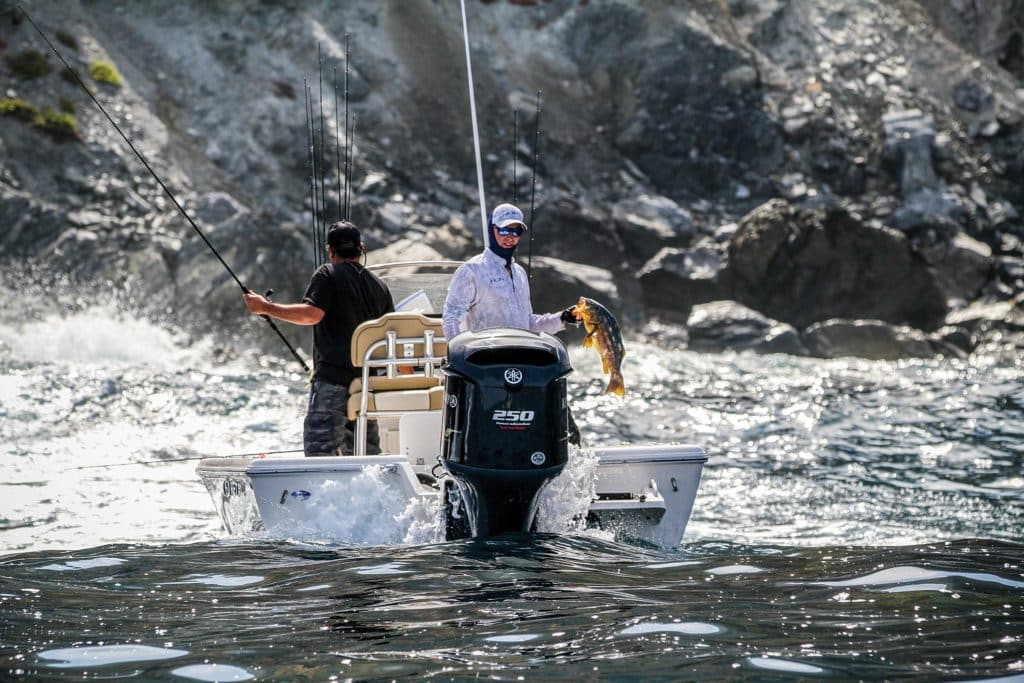
Bluefin tuna swarmed the deep waters swirling above Desperation Reef, off the remote southeast tip of San Clemente Island, more than 60 miles from the closest harbor in the Southern California Bight. The seamount attracts bluefins ranging from school-size 50-pounders to 300-plus-pound cows.
These were the fish Erik Landesfeind had in mind as he set a course for the reef from Long Beach’s Alamitos Bay last summer. His boat, however, was not the offshore battlewagon or large multiengine center-console one might expect for such a passage. He made it there and back on a 22-foot bay boat—a Robalo 226 Cayman with a single Yamaha 200 hp outboard—scoring a number of 70- to 80-pound bluefins during the trip.
Such treks have become increasingly common among a legion of Southern California anglers, who have turned to bay and hybrid boats for targeting not only inshore species but also offshore big game. Some have taken their bay boats as far as the Cortez Bank, an astounding 100 miles off the coast.
Many of today’s bay boats ride as smoothly as deep-V center-consoles of comparable size, Landesfeind contends. “There’s nowhere I wouldn’t take this boat,” he says. “Places like Desperation Reef might seem really far, but with the speed of today’s bay boats, you get there in a hurry.
“A bay boat is the best casting platform for throwing jigs and plugs,” Landesfeind continues. “The bow and stern decks are stable, and you don’t have to worry about your backcast.”
Tournament Birth
While bay boats have enjoyed immense popularity on the East and Gulf of Mexico coasts over the past few decades, they did not appear on the Southern California angling scene in numbers until 12 or 15 years ago. “They started to show up slowly at saltwater bass tournaments,” says Eric Bent, who was helping with the now-defunct Salt Water Bass Anglers tournament circuit at the time. “Gradually, more guys started getting bay boats to fish the bass tour.”
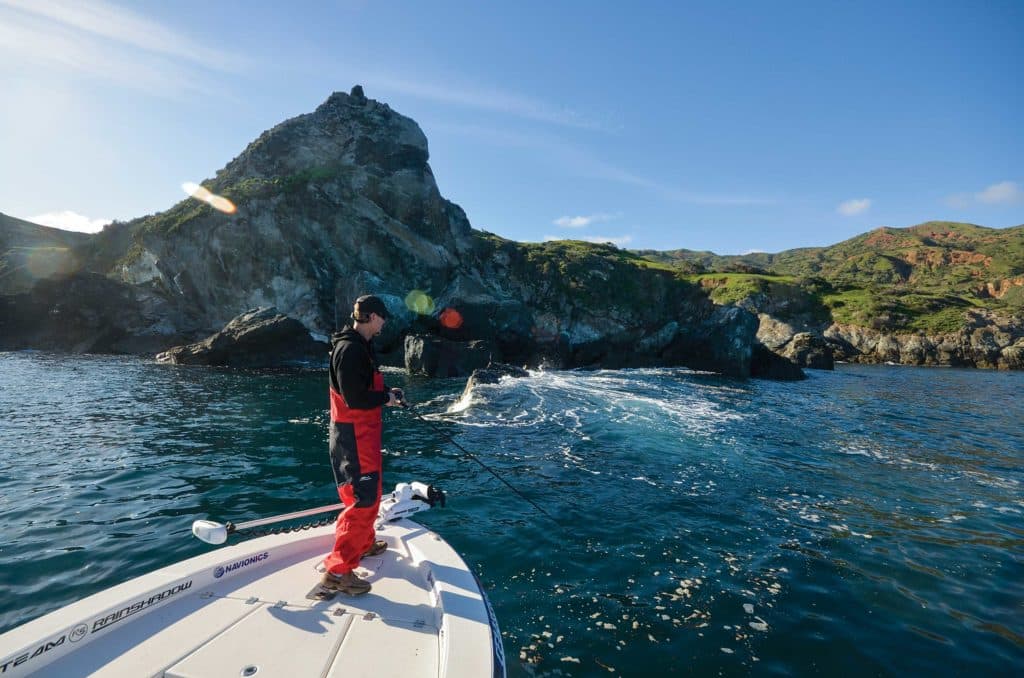
“Today a majority of boats in our Saltwater Bass Series tournaments are bay boats or hybrid models from Everglades, Key West, Pathfinder, Ranger, Skeeter and Robalo,” says Capt. Gerry Mahieu, owner and director of the artificial-lures-only, Southern California-based tournament circuit, patterned largely after freshwater bass events. “Many competitors have realized that bay boats offer the stability, speed and ride quality they need to competitively fish for bass along the coast and islands,” explains Mahieu, who owns a Robalo 226 Cayman powered by a Mercury 250 hp Verado, which he employs for his charter business. “The ability to run a trolling motor on the low-slung bow lets anglers work lures along the edges of shore structure, jetties and kelp beds, areas where calico, barred sand and spotted bay bass live and feed,” he adds.
Calmer Seas
Most anglers use their boats for more than just tournaments, and many have expanded their list of targets to include California yellowtail, mahi, tuna and even marlin.
“Thirty percent of my fishing is offshore,” says Mahieu, who sometimes takes charter clients in pursuit of said fish 50 or more miles offshore. While running such distances in a bay boat might surprise anglers in other regions, these trips are doable because of the configuration of the California coast.
The Southern California Bight bends from Point Conception to Punta Banda, Mexico, encompassing 300 miles of coastline and more than a dozen offshore islands, including the nine Channel Islands. While this region lacks the abundance of protected bays and backwaters of the Eastern Seaboard and Gulf of Mexico, the coastal mountains of the bight block the brunt of prevailing winds from the north, while the islands shield much of the wind from the west. As a result, the ocean is often extraordinarily calm, like a bay, especially in the mornings, offering perfect conditions for bay boats to navigate and fish.
Big-Game Potential
The greater speed of bay boats and hybrids—Mahieu’s bay boat cruises comfortably at about 30 mph—also renders them effective when chasing breaking schools of tuna or yellowtails. “When tuna are after schools of bait, I can get on top of them faster than many other boats,” Mahieu says. And if conditions start to deteriorate, which they often do in the afternoon, his boat lets him get back just as quickly.
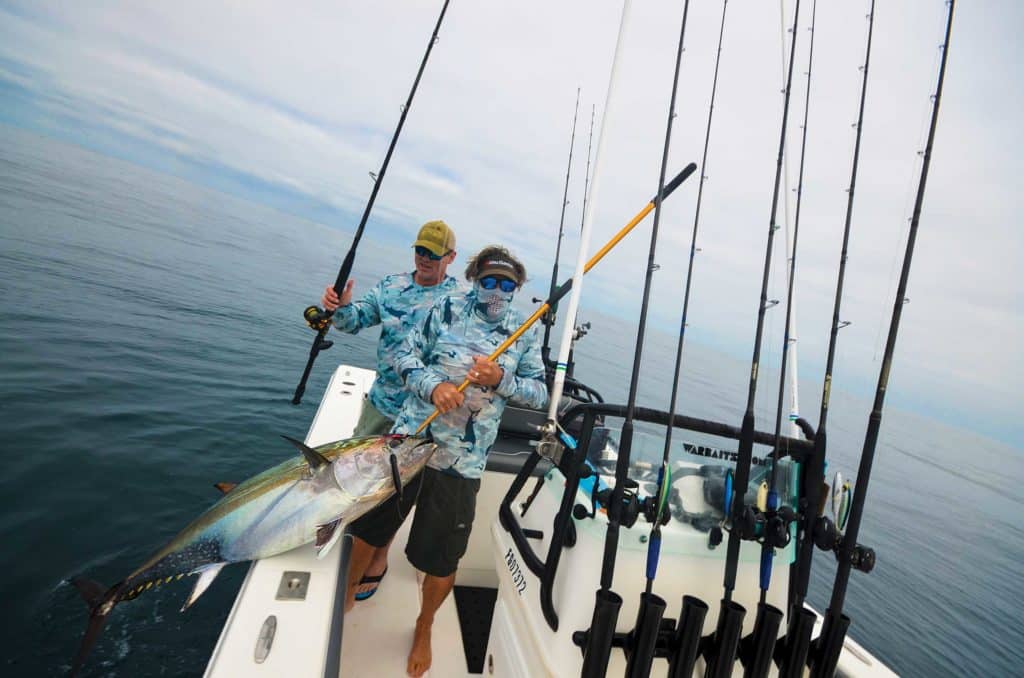
Capt. Jimmy Decker uses his Everglades 243cc to fish for striped marlin when they move into Southern California waters, usually July through October. The stern livewell carries enough Pacific mackerel for sight-casting to tailing billfish from the forward deck. And he added a pair of Precision Econoline 12-foot outriggers with gunwale bases, which allow him to troll a five-lure spread. Once a fish is hooked, Decker quickly pivots the riggers in their bases so they lie flat on the gunwales, eliminating any likely interference.
Rigging Details
Most bay boats and hybrids in Southern California are equipped similarly to those on other coasts, except for one major element: They don’t have T-tops. There are two reasons for that. First, despite California’s reputation for sunny skies, the heat is not nearly as intense as it is in Florida, the upper Gulf or the mid-Atlantic. The cooler waters of the Pacific help moderate the weather. Second, West Coast anglers use longer rods for casting. “A T-top gets in the way when you’re casting the 8- or 9-foot rods we use for metal jigs and plugs,” Landesfeind explains.
Some boat owners, however, add a small arch over the center console to equip the boat with a radar dome to navigate more safely at night or in fog. Unlike anglers on the East and Gulf coasts, few West Coast anglers equip their boats with jack plates because shallow water is virtually nonexistent in this region.
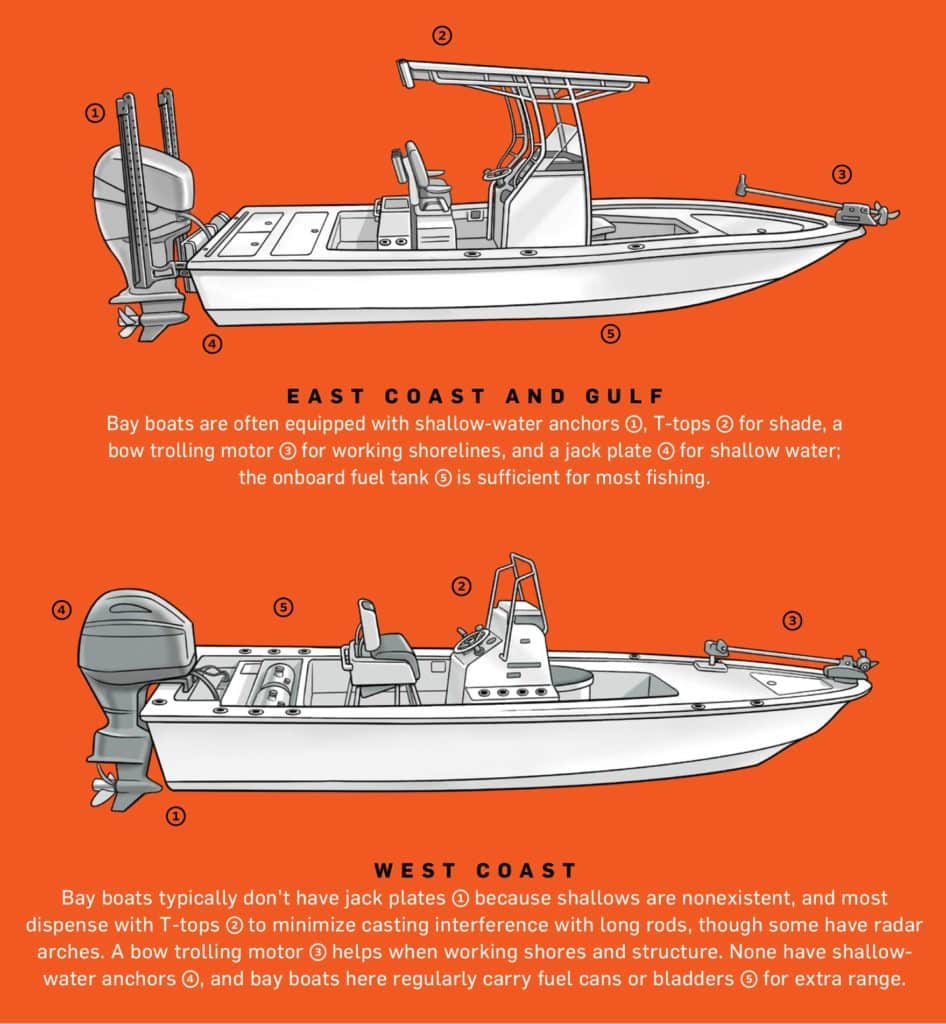
One downside to some bay boats for West Coast anglers is their limited fuel capacity. Because they are designed for fishing bays or coastal waters close to home, popular bay boats such as the Robalo Cayman 226 and Ranger 240 Bahia hold just 60 and 72 gallons, respectively. Because West Coast anglers often run extended distances, bay-boat skippers routinely carry extra fuel in plastic gasoline containers or bladders for long offshore trips, or as an additional margin of safety.
On the other hand, most bay boats come with surprisingly generous live-bait capacity.
The aforementioned Robalo has a 30-gallon stern livewell, the Everglades 243cc carries a 36-gallon livewell, and both work well for SoCal’s famous live-bait fishing techniques.
Trolling-Motor Tricks
While the relatively high bows on many deep-V center-consoles seldom lend themselves well to mounting electric trolling motors, bay boats and hybrids are perfectly suited for it. As a result, anglers can effectively work lures and baits tight to rocky shores and kelp lines.
In addition, the electronic anchoring feature on saltwater trolling motors, known as Spot-Lock on Minn Kota models and Anchor Mode on the Motorguide counterparts, have proven equally effective offshore. SoCal anglers can use this feature to hold position around floating patches of kelp that attract mahi, tuna or yellowtails, a trick impossible to accomplish with a conventional anchor.
Landesfeind uses the same technique when fishing deep structure in spots like Desperation Reef, which is roughly 300 feet deep at its base.
“No need to drop anchor and then pull it back up,” he says. “When we hook a big tuna, we just lift the trolling motor and go chase the fish.”
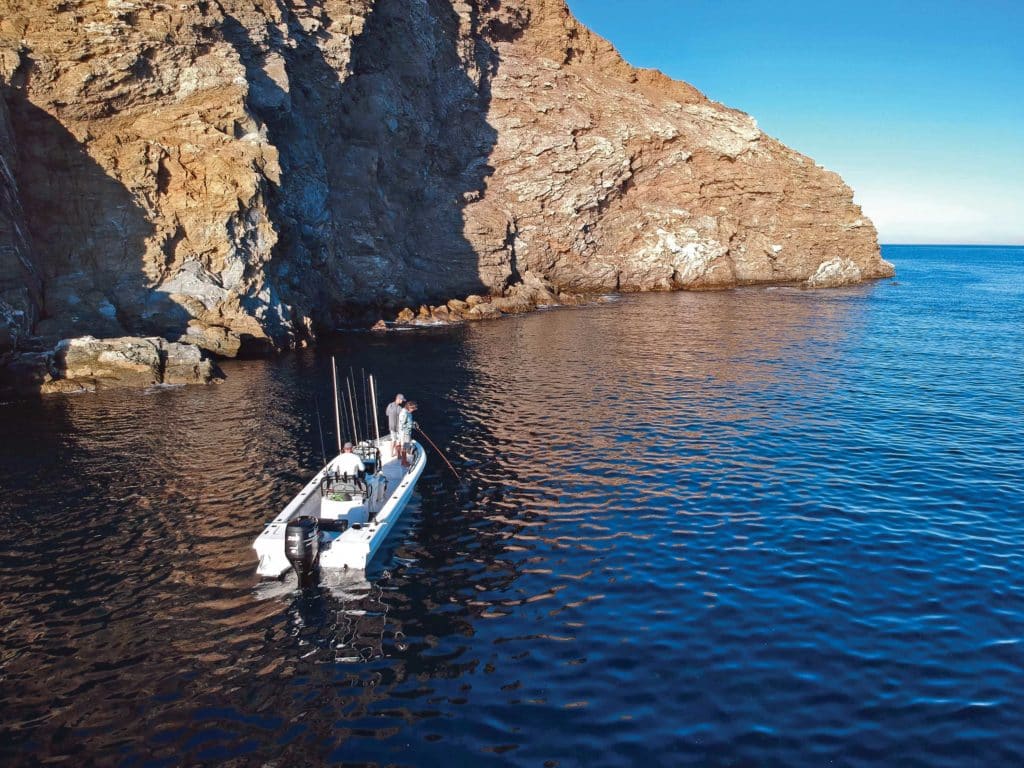
Electronic anchoring is not only convenient, but also allows bay-boat anglers to effectively fish in conditions that aren’t conducive to conventional anchoring techniques, namely when wind opposes current over a structure spot such as a wreck or reef. “With Spot-Lock, I can hold the boat up-current of the spot, and fish baits or lures back over it, even when the wind and current don’t agree,” Mahieu explains.
Considering their versatility, efficiency, stability, and fast, smooth ride, it’s easy to understand why bay boats and hybrid models are steadily gaining popularity in Southern California. Add in the facts that they’re easier on the wallet and to trailer, and you’ve hit all the key factors behind the West Coast bay-boat revolution.









